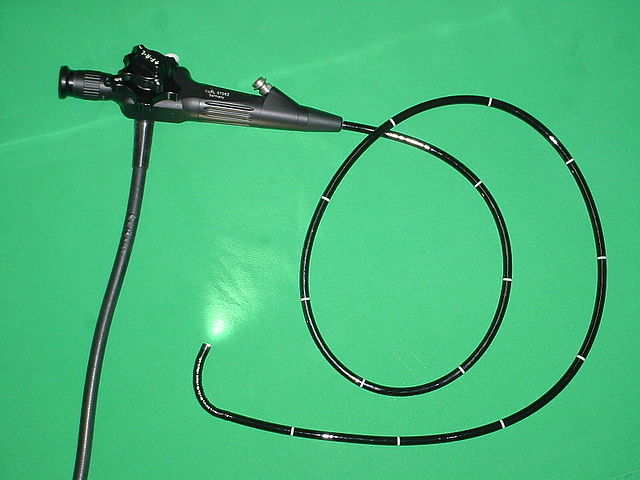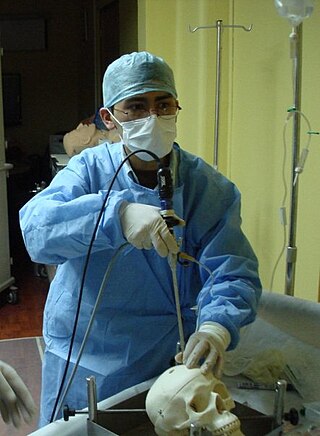Endoscopy means to look inside. This often means looking inside the body for medical reasons with an endoscope.

An endoscope is a medical instrument that is made to see parts inside a patient's body. This has the advantage that observations and certain operations can be done without opening up the body. Whatever precautions are taken, an open body part is always at risk of infection.
The endoscope has a long tube to enter the patient's body and a tiny camera or lens attached to the front of this tube. Sometimes the tube is guided through the body using outside imaging.
It is usually inserted into patient's nose, mouth, or anus, so surgeons can see what is there. If necessary, action can be taken, like getting a tissue biopsy.
Parts
An endoscope has at least some of these parts:
- a rigid or flexible tube.
- a light, which is usually outside the body and delivered by an optical fibre system.
- a lens system which takes the image from the objective lens to the viewer. This can be done by a relay lens system in the case of rigid endoscopes or a bundle of fiberoptics in the case of a fibrescope.
- an eyepiece. Modern instruments may be videoscopes, with no eyepiece. In these a camera transmits image to a screen. This has the advantage that the image can be seen by all in the operating theatre.
- an additional channel to carry medical instruments or manipulators.
Uses

Endoscopy can involve
- The gastrointestinal tract (GI tract):
- esophagus, stomach and duodenum
- small intestine
- colon
- Bile duct
- The respiratory tract
- The nose
- The lower respiratory tract (bronchoscopy)
- The urinary tract
- The female reproductive system
- The cervix
- The uterus
- The Fallopian tubes
- Normally closed body cavities (through a small incision):
- The abdominal or pelvic cavity
- The interior of a joint
- Organs of the chest
- During pregnancy
- The amnion
- The foetus
- Plastic Surgery
- Panendoscopy (or triple endoscopy)
- Combines larynx, esophagogus, and bronchoscopy
- Non-medical uses for endoscopy
- The planning and architectural community have found the endoscope useful for pre-visualization of scale models of proposed buildings and cities
- Internal inspection of complex technical systems
- Endoscopes are also a tool helpful in the examination of improvised explosive devices by bomb disposal personnel.
- The Federal Bureau of Investigation (FBI) uses endoscopes for conducting surveillance in tight spaces.
Related pages
- nuclear medicine
References
Wikiwand in your browser!
Seamless Wikipedia browsing. On steroids.
Every time you click a link to Wikipedia, Wiktionary or Wikiquote in your browser's search results, it will show the modern Wikiwand interface.
Wikiwand extension is a five stars, simple, with minimum permission required to keep your browsing private, safe and transparent.
